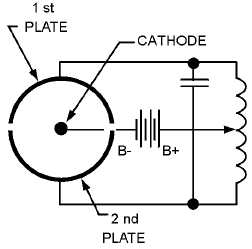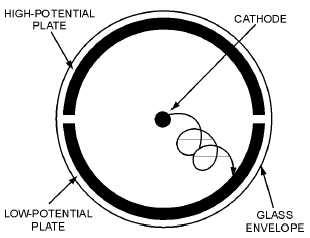2-30
Figure 2-23B.—Split-anode magnetron.
Figure 2-24.—Movement of an electron in a split-anode magnetron.
Here the magnetic field has more effect on the electron and deflects it into a tighter curve. The
electron then continues to make a series of loops through the magnetic field and the electric field until it
finally arrives at the low-potential plate.
Oscillations are started by applying the proper magnetic field to the tube. The field value required is
slightly higher than the critical value. In the split-anode tube, the critical value is the field value required
to cause all the electrons to miss the plate when its halves are operating at the same potential. The
alternating voltages impressed on the plates by the oscillations generated in the tank circuit will cause
electron motion, such as that shown in figure 2-24, and current will flow. Since a very concentrated
magnetic field is required for the negative-resistance magnetron oscillator, the length of the tube plate is
limited to a few centimeters to keep the magnet at reasonable dimensions. In addition, a small diameter
tube is required to make the magnetron operate efficiently at microwave frequencies. A heavy-walled
plate is used to increase the radiating properties of the tube. Artificial cooling methods, such as forced-air
or water-cooled systems, are used to obtain still greater dissipation in these high-output tubes.



